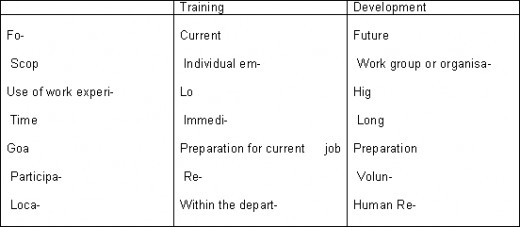Learning and Development: Thoughts on Strategic Human Resource Development

A critical function of any Strategic Human Resources department is to address the development needs of employees. Organisations often need to train and develop staff due to changes in work practices, organisational structure, technology and competition.
Within organisational development there are two elements of training. One is the practical hands on application of delivering training to enable staff to do their job and the second is the long term strategic application of Strategic Human Resources Development (SHRD).
On-the-job Training
In order for organisations to have an effective workforce, training is essential to drive the performance and culture of the organisation. This on the job training is focussed on delivering the outcomes required for the role at the highest possible level and is an ongoing process. The cycle includes:
- Induction training
- Product or service training
- Process training eg selling, planning process etc
- Ongoing coaching
- Performance reviews
- Product, service and process refresher training
Best practise for this type of training is to have the trainers embedded within the department. This creates synergies as the trainers are close to the product and the systems, understanding the complexities of this and noting any the impact to the customer.
By being embedded within the business the research has shown that the trainers can be:
- Nimble – able to react quickly to activity that is occurring and develop remedial programs immediately
- Flexible – delivering training to smaller groups of people
- Tailored – identifying training styles and processes that work better for the participants
- Relevant – training product, systems or processes that have immediate impact and are regularly updated due to changes in the system or processes
- Connected – are a part of the team and feel responsibility for the output, result or productivity
Research has shown a direct link between increased productivity and output (eg sales) based upon relevant, ongoing and timely training that incorporates product and process training combined with ongoing coaching. Further research has also linked ongoing productivity and performance increases when specialist trainers are embedded within the business unit as opposed to a centralised approach.
Training is a planned activity conducted over the short term to impart specific job-related knowledge, skills and experience. The key for on-the-job training is being responsive, flexible and nimble combined with recent knowledge and performance linked KPIs. This is why training is best suited to be within the business unit.

SHRD Training
In order for organisations to gain any real benefit from their training and development programs it must be linked to the organisation’s strategic objectives. At this strategic level HRD is the development of human potential to assist organisations and individuals to achieve their objectives.
HRD includes the following elements:
- Development of a brand of leadership and culture that is driven through HRD programs
- Devising programs that develop the skills, abilities and attitudes for future job roles
- Helping to prepare for change
- Building a stronger future for the organisation and building capacity for future growth
HRD is about delivering programs to the right staff members at the right time in order to develop future capability and skills for the future. In essence SHRD is about leadership, culture and constructing the norms around how-we-do-things-around-here. SHRD is about development that focuses on individual (and hence organisational) learning rather than training and education. It’s learning that goes beyond today’s job.
Research has shown that the SHRD trainers need to be close to the Strategic HR Manager as this is the role that defines the HR strategy and training brand of the organisation. In order to move the firm to a higher level these two elements must be closely aligned. Therefore the role of Organisational Development (as a part of the SHRD strategy) should be located within HR according to best practice.
De Cieri (2003) developed a model that demonstrates that training and development have different attributes and therefore different needs: This is seen in the side panel.
While the research recommends that the SHRD trainer takes an organisational and development position it is important that all trainers within the organisation interact and how contact with this area. As the SHRD area develops the training brand for the organisation and is concerned about developing people the SHRD manager will ensure that the training brand and style is consistent. The role also ensures that the trainers across the organisation have the appropriate skills and qualifications to complete their role. This usually forms a dotted line approach within the organisational structure.
Summary
The research clearly shows that there is a link between performance improvement if trainers are embedded within departments. There is an additional lift if performance KPIs are linked to the outcomes.
Further gains are realised if there is a strategic HR development plan and manager responsible within the SHRM department for developing people within the organisation and defining the training brand for the firm. These are two distinct training roles within the organisation both providing value in different ways. So while they are intrinsically linked they both have different performance outcomes and are therefore best to be separated within the management structure.








